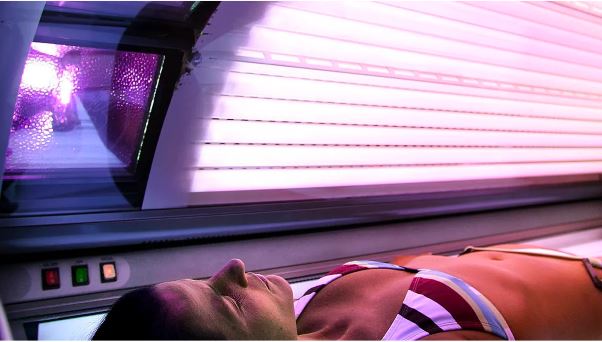Tanning beds are a reasonably popular alternative to classic sunbathing at the beach because they save time and are available year-round. However, many argue about how safe they are for your health and whether they are worth it. One reason is that some users experience a rash from tanning beds, which is definitely uncomfortable.
However, this problem is not as severe as it may seem (in most cases). In this article, we’ll answer why you might have this rash, how to avoid or treat it, and alternatives to tanning beds if they don’t work for you.
4 main causes of tanning bed rash
Hygiene (or lack thereof)
If you go to a tanning salon where a lot of other people will go before and after you, you need to disinfect it yourself (yep, both before and after the procedure). You’re likely to be sweating while tanning, and you’ll be wearing minimal (if any) clothing. So obviously, various infections will be left on the bed. That’s why you should disinfect the bed after yourself.
The same thing happened to the person before you, and there is no guarantee that they disinfected the tanning bed after themselves, so do the same thing before tanning to ensure you’re going to tan into the clean bed.
Tanning bed abuse
You probably know that tanning beds mimic the sun’s UV rays, but why do you tan much faster in tanning beds? It’s not a magic pill, it’s all about the fact that the UV rays in tanning beds are several times more powerful than when you sunbathe.
If you are new to tanning beds or have taken a long break, this powerful exposure to the rays on your skin can hurt you and cause a rash from not being used to it. Plus, if you use the tanning bed too often or for too long, don’t be surprised by side effects like a rash.

Sweat issues
One type of rash you may encounter after tanning beds is a heat rash or miliaria. It occurs because sweat accumulates between layers of skin and causes this effect.
You can experience this problem not only in a tanning bed but also when you are simply in a hot environment. It can cause discomfort (itching) when in contact with clothing. Therefore, it is recommended that you tan in tanning beds with as few (preferably no) clothes on as possible. Also, try shortening your tanning sessions if they cause you to get sweaty.
Not lucky with skin type
I guess it wouldn’t surprise you too much to say that tanning beds dehydrate your skin. But did you know that dryness can turn into a skin rash? If you were born with a dry skin type, unfortunately, you are much more likely to have this problem.
But dry skin is not a death sentence. You can simply use a nourishing cream to soften your skin and prevent a rash.
What does a tanning bed rash look like
Different causes can result in different types of rashes after using a tanning bed. To know what to do about it, you need to understand what type of rash you have. That’s why we’ve put together a small selection of photos with the most common variants.
Heat rash
A heat rash, or miliaria as it is medically known, is a skin reaction resulting from excessive sweating. This irritation usually occurs when clothing or other materials block the pores and the sweat remains inside the skin.


Hives
Hives is characterized by blister-like rashes resembling nettle burns or lemon peel. They can quickly change size, disappear and appear in new areas of the skin within a few hours.

Other options
Other times a rash can come from dry skin, and you can tell when your skin is dry (it is obvious, yes).

Does tanning bed rash go away?
The short answer is yes, it does.
You should not worry too much about it, because usually, the rash passes after a few days (up to 14) with proper skin care. There are also many treatment options, which you can read about in the next section.
How to treat rash from a tanning bed
Firstly, I advise you to take a break from tanning beds if you have any side effects in the form of a rash. New sessions can make it worse if you don’t cure the rash first. What else can be done?
🌞 Avoid direct sunlight
The sun, as well as new visits to the tanning salon, can only increase your rash and discomfort. By the way, try as little as possible to touch the place where you have a rash, do not scratch it even if you want to. It can aggravate the situation.
🍏 Try natural products
You may be surprised, but many natural products can help you with tanning bed rash because they have a soothing effect on the skin. Of course, this is only true if you are not allergic to any particular product.
- Aloe vera
This product is very widely used in skin care products, and for good reason. It can soothe heated skin, rashes, and even burns.
- Cucumber
Cucumbers are rich in vitamins B and C, fiber, and antioxidants. Because of this, they can reduce burns and rashes.
- Banana peel
Yes, yes, not only bananas themselves are useful, but even their peels can be useful to you. They are rich in vitamins A and C and antioxidants. That means they can alleviate itching and rashes, as well as nourish dry skin.
- Coconut oil
This oil is used for a variety of cosmetic purposes, but in the case of rashes, it can be useful to reduce itching and soothe dry skin.

🧊 Use cold compresses and stay in cool places
Cold compresses can soothe your skin, too, and even reduce the appearance of a rash. Also, stay in cool places to avoid the risk of sweating.
🧑⚕️ Consult a doctor
If none of the previous options help, you should see a doctor. Certain medicines help with the rash, but just don’t self-medicate.
How to prevent tanning bed rash
A rash is, of course, a very nasty thing you want to prevent rather than cure. We have some tips for you on this subject. It doesn’t guarantee that you’ll be rash-proof, but it does increase your odds by up to 60-70% (see causes of tanning bed rashes).
- Choose tanning salons where cleanliness is monitored. Pay attention to the reviews, the reputation of the establishment, and the cleanliness not only of the solarium itself but also around it. Even if everything seems to be in order, still use wet wipes or antiseptic before tanning (and afterward, taking care of the following users).
- If you use tanning sprays or lotions and notice rashes afterward, reconsider your products. They may not be right for you.
- Use some SPF cream before tanning (for example, SPF 15 or SPF 20), and after tanning, use some aloe vera gel or 1% hydrocortisone cream. This will help protect your skin before and soothe it after.
- Consider using alternatives to tanning beds. This may be an option if tanning beds make you uncomfortable, and you can’t handle them.

Can you get an allergic reaction to a tanning bed?
Yes, you can be allergic after a tanning bed, and not just to the tanning bed itself. It can be difficult to determine the cause because it could be UV radiation, the creams you use, or even the disinfectant. Besides, you may experience an allergic reaction to the tanning bed if you visit it too often.
If you’re prone to allergies, you can probably figure out what’s wrong by removing one or the other factor from the equation (you might just want to switch tanning beds).

Alternatives to tanning beds
You don’t have to use tanning beds in particular if they make you uncomfortable. There are now many ways to get a tan differently.
Tanning lamps
The closest alternative is home tanning lamps. They work on the same principle as tanning beds but are smaller.
Pros
- They are convenient to use at any time at home, they work quickly, and you will be sure of cleanliness
Cons
- Because of their size, they can’t cover your whole body at once.
Self-tanner
Some girls prefer a variety of creams-auto-tanner. The most difficult thing is to apply it to the face. Even special water sprays are invented for this. They are easy to use and contain hypoallergenic components, which make the product safe to use.
Pros
- Quick and affordable, harmless and non-allergenic.
Cons
- Hard to apply evenly, stains clothes, and does not last long.

Instant tanning
Some choose to go to the experts for the service of instant tanning in the studio. In social networks, many have probably seen ads, how a girl demonstrates her chocolate-colored skin, and where there is a trace of underwear, you can see the difference between the natural shade and the result obtained.
Pros
- Even application.
Cons
- You can’t steam and scrub the skin hard before the procedure, sometimes stains your clothes.
Injections for tanning
This method is resorted to by bodybuilders and fitness bikini participants. The most often used substance is Melanotan I or Melanotan II, synthetic analogs of the hormone that gives our skin a certain degree of pigmentation.
Pros
- Ease of use.
Cons
- It can be dangerous to health, so you should consult a doctor before using it.
But the best alternative to tanning is sunbathing in moderation. The main thing is not to abuse it.
Summary
Well, a tanning bed rash is unpleasant but not fatal. You can prevent it in many cases by adhering to simple hygiene rules and using protective equipment. And if you do encounter this problem, it can also be cured without much effort in 95% of cases.
If you’re one of the five percent who don’t do well with tanning beds, consider alternatives. Try tanning lamps to start with — you may love them even more than tanning sessions in a tanning bed.
FAQ
❓ Why do I get a rash from a tanning bed?
There can be many reasons for a tanning bed rash. The most common include lack of cleanliness, tanning bed abuse, excessive sweating, or too dry skin.
📅 How long does a tanning bed rash last?
Usually, the rash from the tanning bed goes away in a few days, but sometimes the treatment can take up to two weeks.
📌 Can you have an allergic reaction to tanning beds?
Yes, you can be allergic after a tanning bed, and not just to the tanning bed itself. It can be difficult to determine the cause because it could be UV radiation, the creams you use, or even the disinfectant.
💊 How do you treat tanning bed rash?
Sometimes rashes can go away on their own, but you can help them by avoiding the sun, cold compresses, aloe vera, banana peels, cucumbers, or coconut oil. If the situation does not improve, it is better to consult a doctor.





